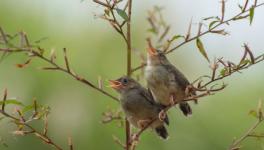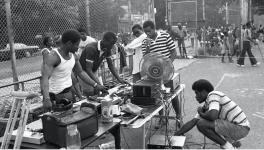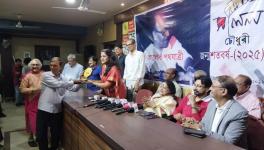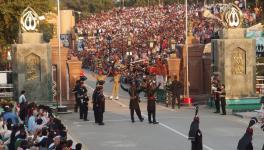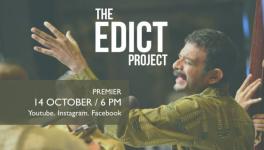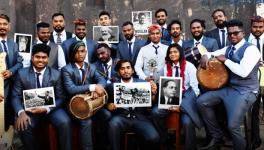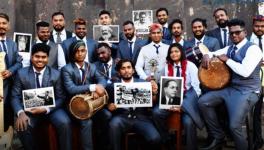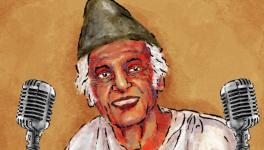Cross Pollinating Musical Cultures is the Only Way: Purbayan Chatterjee
Sitar maestro Purbayan Chatterjee, ace percussionist Taufiq Qureshi, and visionary British-Austrian drummer Bernhard Schimpelsberger recently collaborated on a song called Two Thirds. The upbeat track with Qureshi on djembe, Schimpelsberger on drums, Nakul Chugh on keys, and Chatterjee on the electric see-tar is the virtuoso’s first release of the year. In an exclusive interview, Chatterjee speaks to Neha Kirpal about how the collaboration came together, his electric see-tar, and the Purbayan Arts and Artists Music Foundation that he set up earlier this year, among other things.
Tell our readers about your new song, a collaboration with Taufiq Qureshi and Bernhard Schimpelsberger, called ‘Two Thirds’. What needs to fall in place on a day for a song to come together from one jam session?
‘Two Thirds’ came together in the space of just a few hours. Bernhardt Schimpelsberger was visiting me in Mumbai and during his visit, Taufiq Qureshi was kind enough to drop by my studio. The three of us agreed to jam together with Nakul Chugh on keyboards. We took a simple hook line that had both the major and minor versions of the third note, and ‘Two Thirds’ was born. Initially, we had given the song many other names. Eventually, I decided to go with this name because it was simple and catchy.
The song features the electric see-tar, an instrument that you commissioned. Tell us more about it.
The see-tar or the see-through sitar has been a subject of much discussion. To this day, I receive a lot of questions from fans about where it was made, if it is commercially available, and if they can somehow obtain their version of it. The instrument was partially designed by me, and then the very talented Belgian sitar maker Klaas Bouma agreed to finish the design and execute the production almost a decade ago.
I agree that this is a visually stunning instrument but at the end of the day, it is just another electric sitar. Electric instruments have been in vogue for many years, and many musicians from south India electrified their instruments many years ago. You can run an electric instrument through a processor and explore a variety of tones through one instrument. All this while, your playing technique remains the same as the original instrument—the sitar. I only use this instrument for songs that require different sounds. For example, an edgy overdrive or a mellow infinite kind of tone with the reverb and delay creates a dreamy kind of effect. For most of my music though, I prefer the resident natural acoustic tone of the wooden acoustic sitar, which is organic, distinctive, and sparkling.
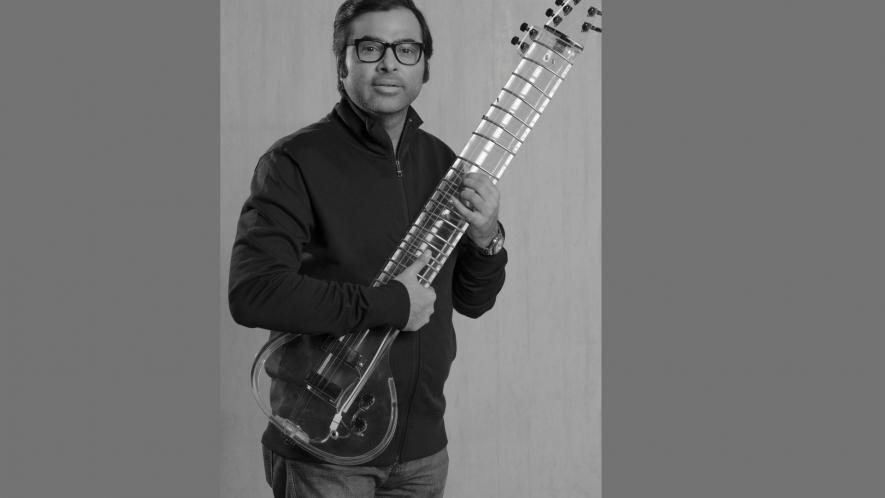
What prompted you to set up the Purbayan Arts and Artists Music Foundation (PAAMF)? And what are your expectations of how it might help others?
For the past decade, I have been observing how the music industry has been changing and evolving from physical sales of records. We have transitioned to the digital way of marketing music. I wanted to be able to help younger aspiring musicians make successful international careers in music. Being a Sitar player, my emphasis is obviously on instrumental music. I would like to work hard and do my bit to give Indian instrumental music a place of pride in the world of music. Instrumentalists are often given a secondary or tertiary role and relegated to the background. In fact, without their brilliance, a certain song may not achieve what the composer or music producer wants to achieve. On the one hand, there is a great emphasis on music production. Therefore, instruments and instrumentalists are, pun intended, “instrumental” in bringing out the brilliance of a song.
On the other hand, of music often tend to look at the vocals as the single point of focus. This is not a fair scenario, and I want to work to somehow remedy this in the future. Earlier this year, I formed PAAMF with my wife, Gayathri, who has always been the greatest proponent of my vision of promoting music. We intend to support and promote all kinds of Indian music on the world stage, especially using digital modes of promotion, and by creating an ecosystem of top quality, collaborative, modern Indian music, which fosters and preserves tradition by taking a future-forward approach.
Tell us more about your upcoming album incorporating trance music.
Apart from working on PAAMF and my current round of tours and concerts, I am also working on two interesting albums. The first is a revisit of my earlier band Shastriya Syndicate, which featured maestros like Rakesh Chaurasia on the flute, Jayanthi Kumaresh on the Veena, Subhankar Banerjee on the tabla, Murad Ali on the sarangi, and Pramath Kiran on percussions. The newer version of this features young brilliant musicians like Amritanshu on the slide guitar, who is also producing this album for me alongside Harshit Shanker on the flute, Nastya Saraswati on the violin and harp, and Megha Rawoot on the sitar. On the tabla, we have Tanay Rege. This is going to be the team behind Shastriya Syndicate, Indian classical music presented in a band format. The music is going to be interactive, pulsating, and fun. Also, in keeping with the need for contemporary sounds, we have incorporated plenty of cutting-edge sounds, brilliantly executed by Amritanshu.
I am also working on another album that presents the sitar in “trance” music. This is a very new genre for me. I am working on this with my long-time friend and partner in crime, Nakul Chugh, who is a brilliant music producer. I am looking forward to the release of both his albums in the near future, perhaps later this year or early next year.
Who or what are some of your biggest musical inspirations?
I have always greatly admired master musicians, who—despite being firmly rooted in tradition—can create a dialogue with various musical cultures. Pandit Ravi Shankar, Ustad Zakir Hussain, Pat Metheny, John McLaughlin, Chick Corea, Sting, and The Beatles are just some names that come to mind.
Then there are great vocalists like Ustad Amir Khan, Ustad Bade Ghulam Ali Khan, great instrumentalists like Ustad Ali Akbar Khan, Ustad Vilayat Khan, and Pandit Nikhil Banerjee who have almost written the thesaurus of Indian music. Modern musicians and composers like Jacob Collier and Michael League are creating an effective pot-pourri of musical sounds which appeal to every musical culture in the world. I admire them all and the list grows every day.
What can fans expect from you next?
The trance album will have some world-class collaborators whose names I will be in a position to divulge soon. My management is working on a tour of Australia for later this summer and a short tour of the United States in October 2023. Through my foundation, I want to release a series of albums of younger artists—some instrumental, some vocal—which will feature collaborations with a few top-ranking young musicians from all over the world. I feel that cross pollinating each other’s musical cultures is the only way forward.
How do you keep your enthusiasm and energy up for what you do? Do musicians also have off days like the rest of us?
The biggest motivating factor for me right now is to try and carve a future for the next generation of Indian musicians. I feel young musicians, particularly classical musicians, and especially instrumentalists, often face a great deal of trepidation in taking up music as a career. It is a challenging and risky business and will always continue to be so. However, I feel that the responsibility always lies with one generation to try and make things a little easier and more comfortable for people who follow in their footsteps. Of course, I do enjoy my days off. I enjoy travelling for leisure and watching a lot of films. But with every passing day, I feel a greater need to motivate myself towards mobilising greater support for Indian music, particularly non-film music.
(Neha Kirpal is a freelance journalist based in Delhi.)
Get the latest reports & analysis with people's perspective on Protests, movements & deep analytical videos, discussions of the current affairs in your Telegram app. Subscribe to NewsClick's Telegram channel & get Real-Time updates on stories, as they get published on our website.









